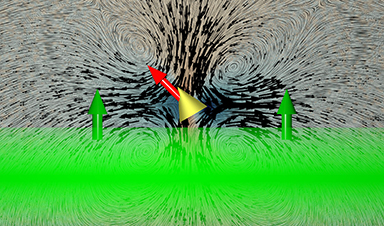Microscopically tiny nanomachines which move like submarines with their own propulsion—for example in the human body, where they transport active agents and release them at a target: What sounds like science fiction has, over the past 20 years, become an ever more rapidly growing field of research. However, most of the particles developed so far only function in the laboratory. Propulsion, for example, is a hurdle. Some particles have to be supplied with energy in the form of light, others use chemical propulsions which release toxic substances. Neither of these can be considered for any application in the body. A solution to the problem could be acoustically propelled particles. Johannes Voß and Prof. Raphael Wittkowski from the Institute of Theoretical Physics and the Center for Soft Nanoscience at the University of Münster (Germany) have now found answers to central questions which had previously stood in the way of applying acoustic propulsion. The results have been published in the journal ACS Nano.
Ultrasound is used in acoustically propelled nanomachines as it is quite safe for applications in the body. Lead author Johannes Voß sums up the research carried out so far as follows: “There are many publications describing experiments. However, the particles in these experiments were almost always exposed to a standing ultrasound wave. This does admittedly make the experiments considerably simpler, but at the same time it makes the results less meaningful as regards possible applications—because in that case traveling ultrasound waves would be used.” This is due to the fact that standing waves are produced when waves traveling in opposite directions overlap one another.
What researchers also did not previously take into account is that in applications the particles can move in any direction. Thus, they left aside the question of whether propulsion depends on the orientation of the particles. Instead, they only looked at particles aligned perpendicular to the ultrasound wave. Now, for the first time, the team of researchers in Münster studied the effects of orientation using elaborate computer simulations.
They came to the conclusion that the propulsion of the nanoparticles depends on their orientation. At the same time, the acoustic propulsion mechanism in traveling ultrasound waves functions so well for all orientations of the particles—i.e. not only exactly perpendicular to the ultrasound wave—that these particles really can be used for biomedical applications. Another aspect the Münster physicists examined was the propulsion the particles exhibited when they were exposed to ultrasound coming from all directions (i.e. “isotropic ultrasound”).
A basis for the step towards application
“Our results showed how the particles will behave in applications and that the propulsion has the right properties for the particles to actually be used in these applications,” Johannes Voß concludes. As Raphael Wittkowski adds, “We have revealed important properties of acoustically propelled nanoparticles which had not previously been studied, but which need to be understood to enable the step to be made from basic research to the planned applications involving the particles.”
The two Münster researchers examined conical particles, as they can move fast even at a low intensity of ultrasound—i.e. they have efficient propulsion—and also they can easily be produced in large numbers. The particles are almost one micrometer in size—almost a thousand nanometres. In comparison, a red blood cell has a diameter of around 7.7 micrometers. This means that the nanoparticles could move through the bloodstream without blocking up the finest blood vessels. “The particle size can be selected in line with what is needed in the particular application intended, and the propulsion mechanism also functions in the case of smaller and larger particles,” Johannes Voß explains. “We simulated the particles in water, but the propulsion is also suitable for other fluids and for tissue.”
By means of computer simulations, the team investigated systems and their properties which could not be studied in the many preceding experiments. Looking into the future, Raphael Wittkowski says, “An important step would be for experiment-based research to move on to looking at these systems.”
News
Lower doses of immunotherapy for skin cancer give better results, study suggests
According to a new study, lower doses of approved immunotherapy for malignant melanoma can give better results against tumors, while reducing side effects. This is reported by researchers at Karolinska Institutet in the Journal of the National [...]
Researchers highlight five pathways through which microplastics can harm the brain
Microplastics could be fueling neurodegenerative diseases like Alzheimer's and Parkinson's, with a new study highlighting five ways microplastics can trigger inflammation and damage in the brain. More than 57 million people live with dementia, [...]
Tiny Metal Nanodots Obliterate Cancer Cells While Largely Sparing Healthy Tissue
Scientists have developed tiny metal-oxide particles that push cancer cells past their stress limits while sparing healthy tissue. An international team led by RMIT University has developed tiny particles called nanodots, crafted from a metallic compound, [...]
Gold Nanoclusters Could Supercharge Quantum Computers
Researchers found that gold “super atoms” can behave like the atoms in top-tier quantum systems—only far easier to scale. These tiny clusters can be customized at the molecular level, offering a powerful, tunable foundation [...]
A single shot of HPV vaccine may be enough to fight cervical cancer, study finds
WASHINGTON -- A single HPV vaccination appears just as effective as two doses at preventing the viral infection that causes cervical cancer, researchers reported Wednesday. HPV, or human papillomavirus, is very common and spread [...]
New technique overcomes technological barrier in 3D brain imaging
Scientists at the Swiss Light Source SLS have succeeded in mapping a piece of brain tissue in 3D at unprecedented resolution using X-rays, non-destructively. The breakthrough overcomes a long-standing technological barrier that had limited [...]
Scientists Uncover Hidden Blood Pattern in Long COVID
Researchers found persistent microclot and NET structures in Long COVID blood that may explain long-lasting symptoms. Researchers examining Long COVID have identified a structural connection between circulating microclots and neutrophil extracellular traps (NETs). The [...]
This Cellular Trick Helps Cancer Spread, but Could Also Stop It
Groups of normal cbiells can sense far into their surroundings, helping explain cancer cell migration. Understanding this ability could lead to new ways to limit tumor spread. The tale of the princess and the [...]
New mRNA therapy targets drug-resistant pneumonia
Bacteria that multiply on surfaces are a major headache in health care when they gain a foothold on, for example, implants or in catheters. Researchers at Chalmers University of Technology in Sweden have found [...]
Current Heart Health Guidelines Are Failing To Catch a Deadly Genetic Killer
New research reveals that standard screening misses most people with a common inherited cholesterol disorder. A Mayo Clinic study reports that current genetic screening guidelines overlook most people who have familial hypercholesterolemia, an inherited disorder that [...]
Scientists Identify the Evolutionary “Purpose” of Consciousness
Summary: Researchers at Ruhr University Bochum explore why consciousness evolved and why different species developed it in distinct ways. By comparing humans with birds, they show that complex awareness may arise through different neural architectures yet [...]
Novel mRNA therapy curbs antibiotic-resistant infections in preclinical lung models
Researchers at the Icahn School of Medicine at Mount Sinai and collaborators have reported early success with a novel mRNA-based therapy designed to combat antibiotic-resistant bacteria. The findings, published in Nature Biotechnology, show that in [...]
New skin-permeable polymer delivers insulin without needles
A breakthrough zwitterionic polymer slips through the skin’s toughest barriers, carrying insulin deep into tissue and normalizing blood sugar, offering patients a painless alternative to daily injections. A recent study published in the journal Nature examines [...]
Multifunctional Nanogels: A Breakthrough in Antibacterial Strategies
Antibiotic resistance is a growing concern - from human health to crop survival. A new study successfully uses nanogels to target and almost entirely inhibit the bacteria P. Aeruginosa. Recently published in Angewandte Chemie, the study [...]
Nanoflowers rejuvenate old and damaged human cells by replacing their mitochondria
Biomedical researchers at Texas A&M University may have discovered a way to stop or even reverse the decline of cellular energy production—a finding that could have revolutionary effects across medicine. Dr. Akhilesh K. Gaharwar [...]
The Stunning New Push to Protect the Invisible 99% of Life
Scientists worldwide have joined forces to build the first-ever roadmap for conserving Earth’s vast invisible majority—microbes. Their new IUCN Specialist Group reframes conservation by elevating microbial life to the same urgency as plants and [...]





















